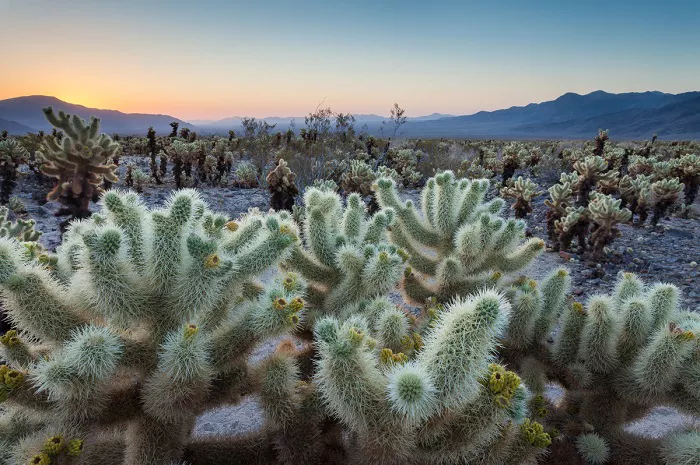The Eight Wonders Trail, known for showcasing some of America’s most iconic national parks, has offered no shortage of awe-inspiring sights. Hikers along the route have already passed through Saguaro, Grand Canyon, Bryce Canyon, and Capitol Reef National Parks. But the journey’s true magic may lie not only in its namesake destinations, but in the unexpected marvels along the way—landscapes that rival the grandeur of any designated park.
Across the first 1,400 miles, travelers have encountered extraordinary terrain that often feels like it belongs in a national park registry. Here are five standout locations from the first half of the journey—unofficial wonders that left a lasting impression.
5. The Cholla Cactus Fields: Beauty and Barbs in Arizona
While the towering saguaro often symbolizes the desert Southwest, it is the cholla cactus that truly transforms parts of the Arizona Trail. These dense, silver-spined plants shimmer in the sun and dominate entire landscapes, creating an otherworldly scene. However, their delicate beauty conceals a more hostile nature. The cholla’s barbed segments detach easily, embedding in skin or clothing with painful efficiency. Known by some hikers as “Sneaky Pete’s,” these hidden hazards are both stunning and treacherous. Despite the occasional injury, the vast cholla fields remain a surreal and unforgettable feature of the trail.
4. The Sedona Detour and Fossil Creek: A Welcome Respite
After enduring freezing conditions near Pine, Arizona, a decision to reroute through lower elevations led to an unexpected highlight. Fossil Creek, a desert oasis fed by crystal-clear springs, offered a rejuvenating pause. Waterfalls, warm air, and lush surroundings provided a stark contrast to previous snow-covered miles.
From there, hikers entered Sedona—an area famed for its red rock formations and spiritual allure. Trails like the Hangover offered challenging terrain and panoramic views, reinforcing the decision to stray from the official path. The experience underscored an important lesson: sometimes the detours offer the most profound rewards.
3. Buckskin Gulch: A Slot Canyon Gateway to Utah
As the trail entered Utah, the imposing slot canyons sparked a mix of awe and apprehension. Buckskin Gulch, one of the first encountered, proved to be a surreal descent into a narrow, winding labyrinth of sandstone. At points, the canyon walls were so close that passage required turning sideways. The hike through Buckskin was brief but transformative—a dreamlike introduction to Utah’s unique geology and an irresistible preview of what lay ahead.
2. Pando and Fish Lake National Forest: An Ancient Giant in the High Country
The climb into Fish Lake National Forest was steep, buggy, and taxing. Mosquitoes swarmed the area, testing even the most seasoned hikers. But as night fell, the air cleared and the sky revealed a dazzling canopy of stars. Morning brought another reward: a quiet perch above Fish Lake and a forest teeming with aspen.
Unbeknownst to many travelers, this unassuming grove is home to Pando—the largest living organism on Earth. Though it appears to be a forest, Pando is actually a single clonal colony of aspen trees connected by one root system, stretching over 100 acres. The encounter with this ancient marvel added a sense of humility and wonder to an otherwise grueling stretch.
1. The Escalante River to Death Hollow and the Boulder Mail Trail
Leaving Escalante, hikers entered a wild and largely untrailed section of southern Utah, wading through the Escalante River and into Death Hollow. Sandstone walls towered above, while the cool, meandering water guided their route. Petroglyphs etched into canyon walls hinted at the region’s deep history.
The path through Death Hollow and up Mamie Creek demanded constant vigilance—slippery rocks, poison ivy, and scrambling over waterfall chutes added both challenge and thrill. Camp came in the form of a sandy bend in the creek, where silence and starlight offered rare tranquility.
The journey culminated in a climb onto the Boulder Mail Trail, once used by horseback mail carriers. The trail’s vibrant, swirling rock formations—red, orange, and cream-colored—formed a natural mosaic beneath open desert skies. Reaching Boulder, Utah, dusty and fulfilled, marked not just the end of a section, but a lasting memory of the trail’s hidden soul.
These five locations may not bear the official status of a national park, but each offers its own brand of wilderness grandeur. Along the Eight Wonders Trail, it’s not just the well-known destinations that inspire wonder—it’s the countless places in between that prove just as unforgettable.

